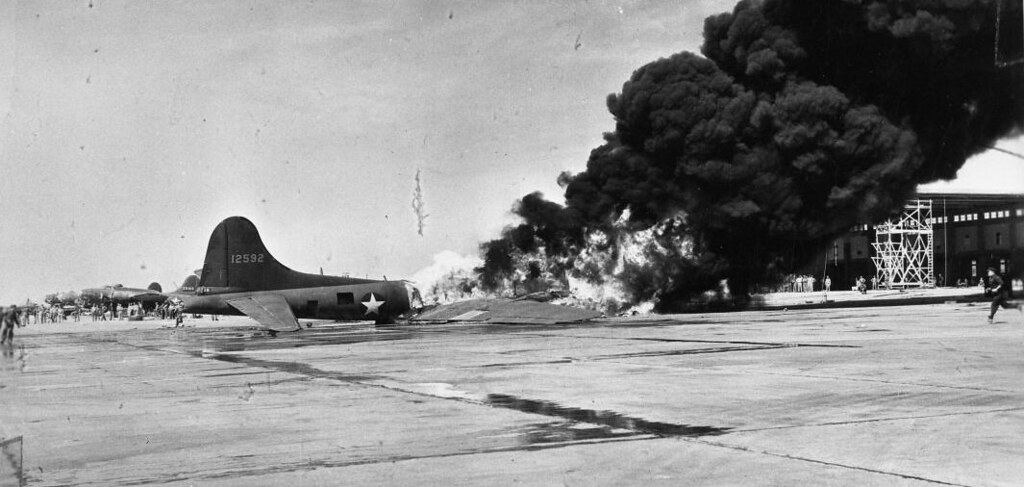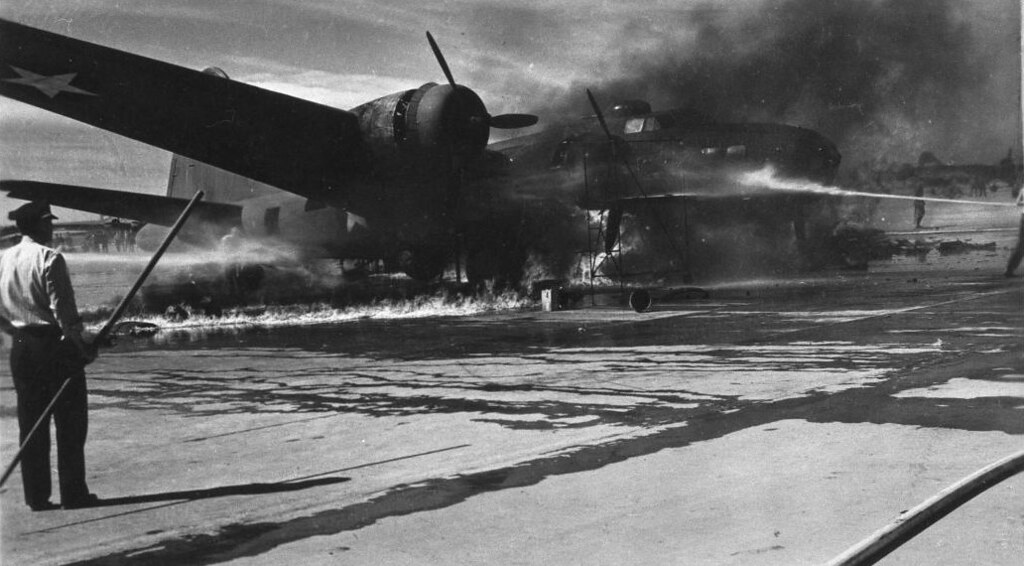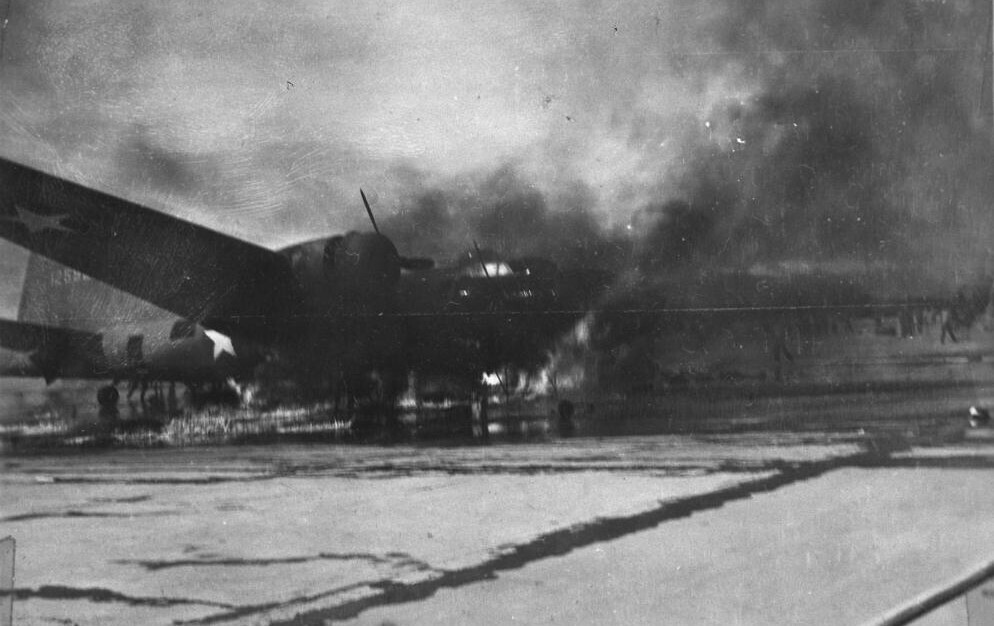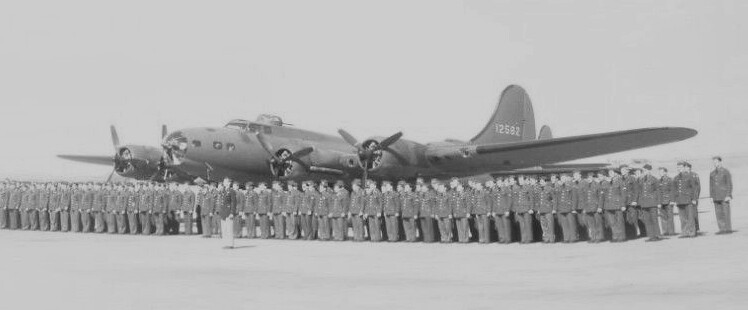Time for a General Inspection ...
Sun Mar 24, 2019 10:17 am
... at Gowen Field, Boise, Idaho on April 10th, 1942.

Gowen Field c 1940's
A Brief History of Gowen Field
In early December of 1940, Adjutant General Adams of the United States Army wired Boise Mayor James Straight that construction of the Boise Air Base had been authorized. Boise was chosen for the erection of an Air Force training center because of its climatic and physical conditions. The original project called for the construction of temporary standard cantonment type buildings to house a wing of medium bombers. The base was to consist of approximately 120 buildings, providing facilities for housing, messing, administration, recreation and warehousing of a troop garrison of 2,500 officers and men, at an authorized cost of $2,115,130.00.
On Jan. 21, 1941, equipment was moved to the desolate sagebrush-covered site and the task of clearing the ground for construction was started. In March of that year, the first spade full of dusty soil was turned by Governor Chase Clark.
The first Commanding Officer of the new base was Col. Robin A. Day who took command on March
12, 1941. Under him as executive officer served Col. Arthur J. Melanson and Capt. John R. Bollinger as adjutant. On Easter Sunday, April 15, 1941, the first original cadre of twenty Soldiers arrived from Salt Lake City to form the 39th Air Base group.
The change of name was made under General Order No. 8, on July 29, 1941 and Boise Air Base officially became Gowen Field. This was in honor of Paul Gowen, a West Point graduate and pilot from Caldwell, Idaho, who was killed in a plane crash in 1938. The choice of name was popular with the local citizens and further solidified the good relations between the military and community. By August of 1941, construction had reached the stage where it was felt that development was adequate to begin operation of the field as an Army Air Corps Base.
Gowen Field remained as an active Army Air Corps Base during WWII, serving as a medium bomber training base. Gowen Field was first home to six B-18 Bolo bombers. However, these aircraft were soon replaced by the faster B-26 Marauders.
The bombing of Pearl Harbor sent Gowen Field into high alert. As with the rest of the nation, activities ramped up. In a short period of time, Gowen Field saw other types of aircraft circulate through its facilities and runways. In January of 1942 Gowen Field received the latest and greatest B-17 Flying Fortress. Soon after, Gowen Field became a combat crew training school for the B-24 Liberator. This would continue throughout the duration of the war.
Soon after the end of the war, the Army locked its gates and returned Gowen Field back over to Boise by the early part of 1946. The gates did not remain locked for long, however.
Idaho’s adjutant general, Gen. Harry Abendroth, requested that Lt. Col. Thomas G. Lanphier establish an Idaho Air National Guard that would lease land from the city. That same year, the Idaho National Guard was born.
Although Idaho’s Air National Guard was established in 1946, it would not move onto Gowen until later that next year. Since then, it has quietly celebrated more than a half century of volun¬teer service to Idaho and the nation by thousands of Citizen-Airmen, sharing the runways with Boise and the community ever since.
A few links for Gowen Field below.
https://www.gowenstrong.com/history.html
http://www.303rdbg.com/pp-gowenfield.html
https://salutetofreedom.org/id.html







Gowen Field c 1940's
A Brief History of Gowen Field
In early December of 1940, Adjutant General Adams of the United States Army wired Boise Mayor James Straight that construction of the Boise Air Base had been authorized. Boise was chosen for the erection of an Air Force training center because of its climatic and physical conditions. The original project called for the construction of temporary standard cantonment type buildings to house a wing of medium bombers. The base was to consist of approximately 120 buildings, providing facilities for housing, messing, administration, recreation and warehousing of a troop garrison of 2,500 officers and men, at an authorized cost of $2,115,130.00.
On Jan. 21, 1941, equipment was moved to the desolate sagebrush-covered site and the task of clearing the ground for construction was started. In March of that year, the first spade full of dusty soil was turned by Governor Chase Clark.
The first Commanding Officer of the new base was Col. Robin A. Day who took command on March
12, 1941. Under him as executive officer served Col. Arthur J. Melanson and Capt. John R. Bollinger as adjutant. On Easter Sunday, April 15, 1941, the first original cadre of twenty Soldiers arrived from Salt Lake City to form the 39th Air Base group.
The change of name was made under General Order No. 8, on July 29, 1941 and Boise Air Base officially became Gowen Field. This was in honor of Paul Gowen, a West Point graduate and pilot from Caldwell, Idaho, who was killed in a plane crash in 1938. The choice of name was popular with the local citizens and further solidified the good relations between the military and community. By August of 1941, construction had reached the stage where it was felt that development was adequate to begin operation of the field as an Army Air Corps Base.
Gowen Field remained as an active Army Air Corps Base during WWII, serving as a medium bomber training base. Gowen Field was first home to six B-18 Bolo bombers. However, these aircraft were soon replaced by the faster B-26 Marauders.
The bombing of Pearl Harbor sent Gowen Field into high alert. As with the rest of the nation, activities ramped up. In a short period of time, Gowen Field saw other types of aircraft circulate through its facilities and runways. In January of 1942 Gowen Field received the latest and greatest B-17 Flying Fortress. Soon after, Gowen Field became a combat crew training school for the B-24 Liberator. This would continue throughout the duration of the war.
Soon after the end of the war, the Army locked its gates and returned Gowen Field back over to Boise by the early part of 1946. The gates did not remain locked for long, however.
Idaho’s adjutant general, Gen. Harry Abendroth, requested that Lt. Col. Thomas G. Lanphier establish an Idaho Air National Guard that would lease land from the city. That same year, the Idaho National Guard was born.
Although Idaho’s Air National Guard was established in 1946, it would not move onto Gowen until later that next year. Since then, it has quietly celebrated more than a half century of volun¬teer service to Idaho and the nation by thousands of Citizen-Airmen, sharing the runways with Boise and the community ever since.
A few links for Gowen Field below.
https://www.gowenstrong.com/history.html
http://www.303rdbg.com/pp-gowenfield.html
https://salutetofreedom.org/id.html






Re: Time for a General Inspection ...
Sun Mar 24, 2019 1:46 pm
Oh boy oh boy oh boy! 
Mark, would it be OK for me to post the image of 41-2553 to its American Air Museum in Britain page (credited to you of course)? It looks like it has some nose art; do you have any higher-rez scans that would show it better? Thanks for posting these!
Mark, would it be OK for me to post the image of 41-2553 to its American Air Museum in Britain page (credited to you of course)? It looks like it has some nose art; do you have any higher-rez scans that would show it better? Thanks for posting these!
Re: Time for a General Inspection ...
Sun Mar 24, 2019 2:38 pm
Chris Brame wrote:Oh boy oh boy oh boy!
Mark, would it be OK for me to post the image of 41-2553 to its American Air Museum in Britain page (credited to you of course)? It looks like it has some nose art; do you have any higher-rez scans that would show it better? Thanks for posting these!
Are you sure its not a blemish on the photo Chris? only the same aircraft hasn't got anything on the nose in the other photos
Re: Time for a General Inspection ...
Sun Mar 24, 2019 2:58 pm
10/11 months later than these photo's, a certain James Stewart spent a couple of months there as a B-17 flight instructor
Re: Time for a General Inspection ...
Sun Mar 24, 2019 5:20 pm
Chris Brame wrote:Mark, would it be OK for me to post the image of 41-2553 to its American Air Museum in Britain page
Of course. No need to credit me though. I don't own them. See the link
Here's a set that is not as 'pretty' as the first set. This I believe is Pyote AAF c 1943. Perhaps 19th BG forts. Destroyed B-17 is unknown to me.




I'm not sure 41-2592 is the same fort as the one destroyed above. Unless they allowed it to burn all the way back to the tail.

Re: Time for a General Inspection ...
Sun Mar 24, 2019 5:51 pm
I lived in Boise 1978-81 and worked at the airport for awhile.
A great airport (back then at least) for airplane watching.
An ANG F-102 on a stick, they were then flying Phantoms, a nearby McDonald's filled with huge photos of ANG F-4s and instrument bits in neat displays, a Forest Service compound with a C-47 on its belly for smoke jumper training and a nearby grounded H-13 still in Army markings, lots of visiting warbirds, B-17s in the summer, I met Mr. Sanders in his Sea Fury, Clay Lacey kept a turbine Porter for flights to his mountain cabin,and earlier in the 70s there was a B-25 that slowly was disassembled...IIRC, it has been restored (if anyone has details, I'd like to know more).
On a daily basis there were lots of 185s and 205/206s (Cessnas, not Bells) heading into the back country. Today I understand there are a lot of B-N Islanders (think of a fixed gear Aero Commander) doing that work.
A great airport (back then at least) for airplane watching.
An ANG F-102 on a stick, they were then flying Phantoms, a nearby McDonald's filled with huge photos of ANG F-4s and instrument bits in neat displays, a Forest Service compound with a C-47 on its belly for smoke jumper training and a nearby grounded H-13 still in Army markings, lots of visiting warbirds, B-17s in the summer, I met Mr. Sanders in his Sea Fury, Clay Lacey kept a turbine Porter for flights to his mountain cabin,and earlier in the 70s there was a B-25 that slowly was disassembled...IIRC, it has been restored (if anyone has details, I'd like to know more).
On a daily basis there were lots of 185s and 205/206s (Cessnas, not Bells) heading into the back country. Today I understand there are a lot of B-N Islanders (think of a fixed gear Aero Commander) doing that work.
Re: Time for a General Inspection ...
Sun Mar 24, 2019 6:50 pm
From Joe Baugher's site
41-2592
delivered to Pendleton Feb 24, 1942;
transferred to Cheyenne May 6, 1942;
transferred to Alamogordo Jun 19, 1942;
transferred to Eglin Aug 18, 1942;
transferred to Pyote Jan 11, 1943; crashed and then WO Feb 22, 1943.
From earlier
41-2553
delivered to Pendleton Feb 5, 1942;
transferred to Boise Mar 30, 1942;
transferred to Cheyenne May 6, 1942;
transferred to Alamogordo Jun 18, 1942;
transferred to Westover Jul 2, 1942;
transferred to Wendover Jul 21, 1942;
transferred to Westover Aug 11, 1942;
transferred to Sebring Sep 12, 1942;
transferred to Hillsboro Jun 23, 1943;
transferred to Sebring Jul 4, 1943;
transferred to RFC and sold for scrap) at Albuquerque Jun 28, 1945.
41-2592
delivered to Pendleton Feb 24, 1942;
transferred to Cheyenne May 6, 1942;
transferred to Alamogordo Jun 19, 1942;
transferred to Eglin Aug 18, 1942;
transferred to Pyote Jan 11, 1943; crashed and then WO Feb 22, 1943.
From earlier
41-2553
delivered to Pendleton Feb 5, 1942;
transferred to Boise Mar 30, 1942;
transferred to Cheyenne May 6, 1942;
transferred to Alamogordo Jun 18, 1942;
transferred to Westover Jul 2, 1942;
transferred to Wendover Jul 21, 1942;
transferred to Westover Aug 11, 1942;
transferred to Sebring Sep 12, 1942;
transferred to Hillsboro Jun 23, 1943;
transferred to Sebring Jul 4, 1943;
transferred to RFC and sold for scrap) at Albuquerque Jun 28, 1945.
Re: Time for a General Inspection ...
Mon Mar 25, 2019 1:15 pm
I found these shots in a Texas photo archive:



Pretty sure this was an accident during maintenance (note all the access panels on the ground, and the mechanics' stand in front of engine #3); pretty much a duplicate of what happened to B-17B 38-584 (Mary Ann from the movie Air Force). (Edit 10-5-20: found out it was a different sharkfin Fort destroyed by fire, not 38-584.)
And one from happier times:

The row of four planes (42-30379, 30391, 3392 and 3351) all went into combat in the ETO.



Pretty sure this was an accident during maintenance (note all the access panels on the ground, and the mechanics' stand in front of engine #3); pretty much a duplicate of what happened to B-17B 38-584 (Mary Ann from the movie Air Force). (Edit 10-5-20: found out it was a different sharkfin Fort destroyed by fire, not 38-584.)
And one from happier times:

The row of four planes (42-30379, 30391, 3392 and 3351) all went into combat in the ETO.
Last edited by Chris Brame on Mon Oct 05, 2020 9:10 pm, edited 1 time in total.
Re: Time for a General Inspection ...
Mon Mar 25, 2019 5:12 pm
JohnB wrote:...and earlier in the 70s there was a B-25 that slowly was disassembled...IIRC, it has been restored (if anyone has details, I'd like to know more).
.
This sounds like the B-25-
http://www.warbirdregistry.org/b25regis ... 86872.html